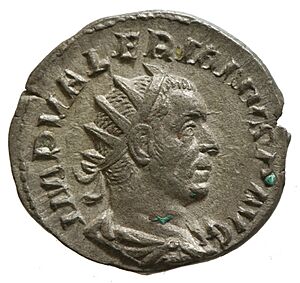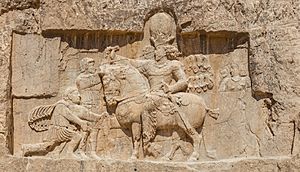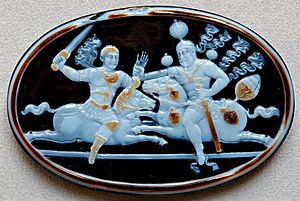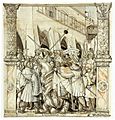Valerian (emperor) facts for kids
Quick facts for kids Valerian |
|||||||||
|---|---|---|---|---|---|---|---|---|---|
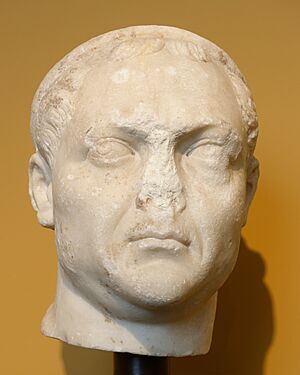
Bust, Ny Carlsberg Glyptotek
|
|||||||||
| Roman emperor | |||||||||
| Reign | September 253 – June 260 | ||||||||
| Predecessor | Aemilian | ||||||||
| Successor | Gallienus (alone) | ||||||||
| Co-emperor | Gallienus | ||||||||
| Born | c. 199 | ||||||||
| Died | After 260 or 264 AD Bishapur or Gundishapur |
||||||||
| Spouse |
|
||||||||
| Issue Detail |
|
||||||||
|
|||||||||
| Dynasty | Valerian | ||||||||
Valerian (/vəˈ[unsupported input]iən/; Latin: Publius Licinius Valerianus; c. 199 – 260 or 264 AD) was a Roman emperor. He ruled from 253 to 260 AD. Valerian is famous for being the first Roman emperor ever captured in battle. He was taken by the Persian emperor Shapur I after the Battle of Edessa. This event shocked the entire Roman Empire. His capture caused great instability and led to many new stories about the Roman Empire.
Contents
Valerian's Early Life and Rise to Power
Unlike many other leaders during the difficult "Crisis of the Third Century," Valerian came from a noble Roman family. We do not know much about his early life. We know he married Egnatia Mariniana. They had two sons: Publius Licinius Egnatius Gallienus and Licinius Valerianus. Gallienus later became co-emperor with his father.
Valerian's Political Career
Valerian became a Roman consul for the first time around 238 AD. A consul was a high-ranking official in ancient Rome. In 238, he was also the leader of the Roman Senate. This meant he was an important voice in the Roman government.
In 251 AD, Emperor Decius wanted to bring back the role of "censor." This job had huge powers, almost like an emperor. The Senate chose Valerian for this role, but he did not accept it. When Decius left Rome for a military campaign, Valerian was left in charge of the city.
Becoming Emperor
Under Emperor Trebonianus Gallus, Valerian was put in charge of an army. This army was likely meant to fight the Persians. However, Trebonianus Gallus faced a rebellion from Aemilianus in 253 AD. Gallus asked Valerian for help.
Valerian marched his army south, but he was too late. Gallus was killed by his own soldiers, who then joined Aemilianus. Valerian's soldiers then declared him emperor. When he reached Rome in September, Aemilianus's soldiers switched sides. They killed Aemilianus and proclaimed Valerian emperor. The Roman Senate quickly accepted Valerian as the new ruler.
Valerian's Rule and Capture
Valerian's first action as emperor was to make his son, Gallienus, a co-emperor. This meant they would rule together. At the start of his reign, problems grew worse in Europe. The western parts of the empire became very chaotic. In the East, the city of Antioch was taken by a Persian ally. Armenia was also taken by Shapur I, the Persian king.
Valerian and Gallienus decided to split the empire's problems. Gallienus took charge of the West. Valerian went East to deal with the Persian threat.
Fighting the Persians
Valerian became consul again in 254, 255, and 257 AD. By 257, he had successfully taken back Antioch. He also returned the province of Syria to Roman control. The next year, the Goths attacked parts of Asia Minor.
In 259, Valerian moved his army to Edessa. But a terrible disease, the plague, killed many Roman soldiers. This greatly weakened the Roman army. The Persians then surrounded the city. In 260 AD, probably in June, Valerian was defeated in the Battle of Edessa. He was captured and remained a prisoner for the rest of his life. Valerian's capture was a huge defeat for the Romans.
Persecution of Christians
While fighting the Persians, Valerian sent two letters to the Roman Senate. These letters ordered strong actions against Christians. The first letter, sent in 257, commanded Christian priests to offer sacrifices to the Roman gods. If they refused, they would be sent away from Rome.
The second letter, sent the next year, ordered that Christian leaders be executed. It also said that Christian senators and knights had to worship the Roman gods. If they refused, they would lose their titles and property. If they still refused, they would be executed. Roman women who would not give up their faith would lose their property and be sent away. Government workers and members of the Imperial household who would not worship the Roman gods would become slaves. They would be sent to work on the emperor's lands. This shows that Christians were already in many important positions at that time.
Many prominent Christians were executed during this time. These included Pope Sixtus II and Saint Lawrence in 258. Others like Denis in Paris and Cyprian in Carthage were also executed. When Valerian's son Gallienus became emperor in 260, he stopped these persecutions.
Valerian's Death in Captivity
Historians have different ideas about what happened to Valerian after he was captured.
Different Accounts of His Death
One early writer, Eutropius, wrote that Valerian "grew old in shameful slavery among the Parthians." Another early Christian writer, Lactantius, said that Valerian was treated very badly by his captors. Lactantius claimed that Shapur used Valerian as a human footstool when getting on his horse. According to this story, Valerian offered a large sum of money for his freedom. Lactantius also claimed that Shapur forced Valerian to swallow melted gold. However, many historians believe Lactantius's account might be exaggerated because he disliked the Persians.
A Different View of His Captivity
Modern historians, like Touraj Daryaee, suggest a different story. They believe Shapur I sent Valerian and some of his army to the city of Bishapur or Gundishapur. There, they lived in relatively good conditions. Shapur used the captured Roman soldiers for building projects. The Band-e Kaisar (Caesar's dam) in Iran is an example of Roman engineering from this time.
In stone carvings found in Iran, Valerian is shown holding hands with Shapur I. This is a sign of submission, but not necessarily harsh treatment. An early Persian scholar, Abu Hanifa Dinawari, wrote that Shapur settled the prisoners in Gundishapur. He then released Valerian, as promised, after the dam was built.
The exact truth about Valerian's death remains a mystery.
Family
- Gallienus was Valerian's son and co-emperor. He ruled until he was assassinated in 268 AD.
- Licinius Valerianus was Valerian's other son. He was a consul in 265. He was likely killed by other leaders sometime between 260 and 268 AD.
| Aulus Egnatius Priscillianus philosopher |
|||||||||||||||||||||||||||||||||||||||||||||||||||||
| Quintus Egnatius Proculus consul suffectus |
Lucius Egnatius Victor | ||||||||||||||||||||||||||||||||||||||||||||||||||||
| Egnatius Victor Marinianus consul suffectus |
1.Mariniana | Valerian Emperor 253-260 |
2.Cornelia Gallonia | ||||||||||||||||||||||||||||||||||||||||||||||||||
| previous Aemilianus Emperor 253 |
(1) Gallienus Emperor 253-268 ∞ Cornelia Salonina |
(2) Licinius Valerianus consul suffectus |
Claudius Gothicus Emperor 268-270 |
Quintillus co-emperor 270 |
Aurelian Emperor 270-275 ∞ Ulpia Severina |
||||||||||||||||||||||||||||||||||||||||||||||||
| Valerian II caesar |
Saloninus co-emperor |
Marinianus consul 268 |
|||||||||||||||||||||||||||||||||||||||||||||||||||
Images for kids
-
The Humiliation of Emperor Valerian by Shapur I, a painting by Hans Holbein the Younger, around 1521.
See also
 In Spanish: Valeriano para niños
In Spanish: Valeriano para niños
- Gallienus usurpers for other people who tried to take power during Valerian and Gallienus' reigns.
- Valeriana, a type of plant named after the emperor.


